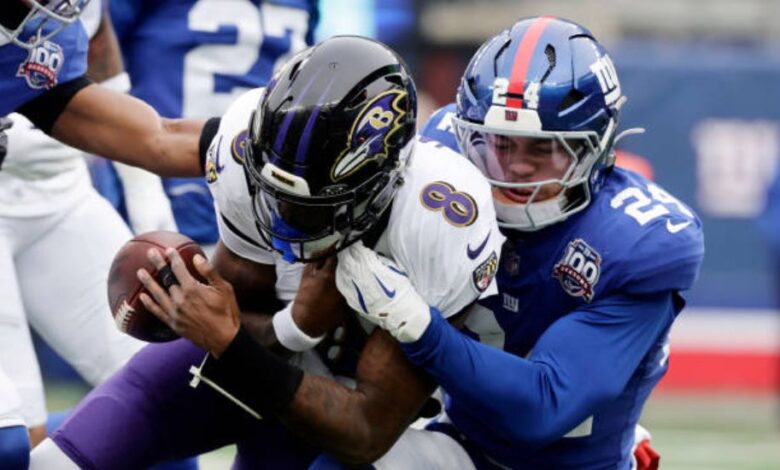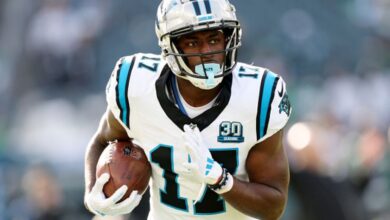Baltimore Ravens vs New York Giants Match Player Stats — Complete Breakdown and Insights

The clash between the Baltimore Ravens and the New York Giants at MetLife Stadium on December 15, 2024, delivered an unforgettable spectacle of offensive power and precision. The Ravens dominated nearly every facet of the game, crushing the Giants 35–14 in a performance that underscored why Baltimore continues to be one of the most well-rounded teams in the league. This wasn’t just a win — it was a clinic in execution, efficiency, and adaptability.
From Lamar Jackson’s near-perfect passing day to Rashod Bateman’s breakout showing, every aspect of Baltimore’s play reflected confidence and balance. The Giants, on the other hand, struggled to establish rhythm, faltering on both sides of the ball. In this comprehensive breakdown, we’ll dive deep into the player stats, team performance, turning points, and tactical insights that defined this matchup.
Team Performance Overview
Right from kickoff, the Ravens looked sharper, faster, and more composed. They outgained the Giants by a margin of 445 total yards to 236, showing complete control over the flow of the game. The Ravens converted 9 of 11 third downs (81.8%), while the Giants managed only 2 of 12 (16.7%) — a staggering contrast that speaks volumes about discipline and play-calling efficiency.
Baltimore ran the ball for 170 yards on the ground, while New York managed only 55. Even with 12 penalties for 112 yards, the Ravens’ dominance wasn’t threatened. They executed with purpose, maintained balance between run and pass, and punished the Giants whenever they left an opening.
The Giants simply couldn’t keep pace. Their offensive drives stalled repeatedly, their defense gave up explosive plays, and their quarterback situation crumbled midgame. Every statistical category leaned heavily in Baltimore’s favor, illustrating how complete their victory truly was.
The Ravens Offense: A Masterclass in Efficiency
Lamar Jackson’s Statement Game
Lamar Jackson delivered one of the finest performances of his career — 21 completions on 25 attempts (84%) for 290 yards and 5 touchdowns, without throwing an interception. His passer rating of 154.6 was near perfection, showcasing not only accuracy but also decisiveness.
What stood out wasn’t just the stats — it was the command. Jackson dissected the Giants’ defense with calm precision, exploiting mismatches and connecting on explosive plays. He threw touchdown passes of varying distances, from short red-zone strikes to a 49-yard bomb that broke the Giants’ coverage open. Adding another 65 rushing yards on 6 carries, Jackson demonstrated once again why he’s among the league’s most dynamic dual-threat quarterbacks.
It was a statement performance — not just to secure a win, but to remind everyone that when Jackson is in rhythm, the Ravens can look unstoppable.
The Receiving Corps Shines
While Jackson was the orchestrator, his receivers played their parts beautifully. Rashod Bateman had one of his best outings of the season, catching 3 passes for 80 yards and 2 touchdowns. His blend of speed and crisp route running repeatedly punished the Giants’ secondary, especially on deep routes.
Mark Andrews, Baltimore’s reliable tight end, grabbed 2 passes for 24 yards and a touchdown, setting a new franchise record for career receiving touchdowns in the process. Devontez Walker, meanwhile, celebrated his first career touchdown on a 21-yard reception, a promising sign for the team’s offensive depth.
Justice Hill contributed in multiple ways — recording 5 receptions for 61 yards and a touchdown, providing Jackson a consistent short-yardage outlet that helped sustain drives. Collectively, the receiving unit showed versatility and chemistry, adjusting fluidly to whatever the defense offered.
The Ground Game
Even with the passing fireworks, the Ravens stayed faithful to their run-first philosophy. Derrick Henry led the backfield with 14 carries for 67 yards, averaging nearly five yards per attempt. While he didn’t score, his presence helped open lanes for play-action passes, forcing the Giants to respect the run.
Justice Hill and Lamar Jackson added valuable yardage with their legs, helping Baltimore control possession and keep the Giants’ defense gasping for breath. The balance between passing (290 yards) and rushing (170 yards) highlighted the offensive coordinator’s commitment to adaptability — a key reason for the Ravens’ sustained dominance.
The Giants’ Offensive Struggles
Quarterback Chaos
The Giants’ quarterback situation was in turmoil even before kickoff, and things only worsened as the game progressed. Tommy DeVito, starting under center, completed 10 of 13 passes for 68 yards before leaving with a concussion. His replacement, Tim Boyle, went 12 of 24 for 123 yards, adding a touchdown but also throwing an interception.
The lack of stability disrupted offensive rhythm and left the Giants unable to sustain drives. Their longest drive of the game came aided by multiple Baltimore penalties — a clear indication that the Giants weren’t generating offense organically.
Receiving and Rushing
Despite the struggles, rookie wide receiver Malik Nabers was a bright spot, recording 10 catches for 82 yards and a touchdown. His route running and toughness over the middle gave glimpses of his star potential. However, without a consistent passing attack, Nabers’ efforts were mostly isolated moments of brilliance in an otherwise quiet offense.
Running back Devin Singletary had a modest day with 8 carries for 25 yards and a short touchdown, plus 3 receptions for 16 yards. Unfortunately, the running game never got off the ground, averaging just 2.8 yards per carry.
The Giants’ inability to run effectively made their offense one-dimensional, allowing Baltimore’s pass rush to tee off and force quick throws.
Defensive Breakdown
Ravens Defense: Controlling the Tempo
While the offense stole the headlines, the Ravens’ defense played a crucial complementary role. They limited the Giants to just 236 total yards, constantly forced third-and-long situations, and never allowed New York to find rhythm.
Linebacker Malik Harrison was among the standouts, recording 8 total tackles, 1 sack, and 2 quarterback hits. The secondary held strong despite limited blitzing, while the front seven clogged running lanes and collapsed the pocket when needed.
The defense also thrived situationally — holding the Giants to just two third-down conversions out of twelve. That dominance ensured Lamar Jackson and company frequently had short fields to work with, turning defense into offense.
Giants Defense: Outmatched and Overwhelmed
The Giants defense entered the game knowing they’d have to contain Lamar Jackson — a nearly impossible task when he’s locked in. They gave up multiple explosive plays, including long touchdown passes where coverage completely broke down. Their tackling was inconsistent, and their pass rush barely reached Jackson.
Safety Dane Belton led the team with 15 tackles, which tells its own story: when a safety makes that many stops, it means the front seven isn’t doing enough. The Giants’ biggest problem wasn’t effort — it was structural. Baltimore consistently used motion, misdirection, and tempo to create mismatches and confusion.
By the time adjustments were made, the scoreline was already out of reach.
Turning Points and Key Moments
- The 49-yard Touchdown to Bateman: Midway through the second quarter, Jackson found Bateman deep downfield for a 49-yard score. That single play broke the Giants’ defensive spirit and stretched Baltimore’s lead to two scores.
- Third-Down Perfection: The Ravens converted over 80% of their third downs. Each conversion deflated the Giants’ defense, extending drives and keeping their offense off the field.
- DeVito’s Exit: When Tommy DeVito left the game with a concussion, the Giants’ last semblance of rhythm disappeared. Boyle’s entry couldn’t revive the offense.
- Late Defensive Collapse: Even in the fourth quarter, with the game out of reach, the Giants gave up chunk plays that padded Baltimore’s stats and reflected the widening gap in depth and morale.
These turning points not only shaped the scoreboard but also revealed the contrasting poise and preparation between both teams.
The Bigger Picture — What the Stats Tell Us
- Efficiency Trumps Volume: The Ravens didn’t need dozens of possessions; they simply maximized every one. Their balance of 445 total yards with minimal incompletions and high third-down conversions demonstrated a model of efficient offense.
- Field Position Wins Games: With solid special teams and minimal negative plays, Baltimore consistently began drives in advantageous territory.
- Quarterback Quality Defines Teams: Lamar Jackson’s mastery contrasted sharply with New York’s instability, reminding fans that the quarterback position remains the NFL’s great equalizer.
- Discipline and Depth: Even with 12 penalties, Baltimore’s overall structure and depth allowed them to stay dominant, while New York’s lack of cohesion led to collapse.
- Big Plays Make the Difference: Baltimore generated multiple plays of over 20 yards — four of which resulted in touchdowns. Those momentum-shifting moments separated a good team from a struggling one.
Player Highlights Summary
Baltimore Ravens
- Lamar Jackson: 21/25, 290 YDS, 5 TD, 0 INT; 65 rush yards
- Rashod Bateman: 3 REC, 80 YDS, 2 TD
- Mark Andrews: 2 REC, 24 YDS, 1 TD
- Justice Hill: 5 REC, 61 YDS, 1 TD
- Derrick Henry: 14 CAR, 67 YDS
- Malik Harrison: 8 TKL, 1 SACK, 2 QB Hits
New York Giants
- Tim Boyle: 12/24, 123 YDS, 1 TD, 1 INT
- Tommy DeVito: 10/13, 68 YDS
- Malik Nabers: 10 REC, 82 YDS, 1 TD
- Devin Singletary: 8 CAR, 25 YDS, 1 TD; 3 REC, 16 YDS
- Dane Belton: 15 TKL
Post-Game Reflections
The numbers tell a story of dominance, but the emotional takeaway was just as stark. Baltimore looked like a championship-caliber unit — calm under pressure, explosive when opportunity knocked, and unified in purpose. Every drive felt calculated, every defensive stand meaningful.
For the Giants, this loss exposed long-standing issues: inconsistency at quarterback, porous pass protection, and defensive confusion in coverage. Malik Nabers offered a glimmer of future hope, but the present remains murky.
Baltimore, on the other hand, walked off the field not just with another win, but with renewed confidence heading toward the playoffs. Their balance, leadership, and adaptability have once again set them apart as one of the NFL’s most complete teams.
Final Thoughts
When analyzing the Baltimore Ravens vs New York Giants match player stats, one conclusion stands out: Baltimore didn’t just win — they executed perfection in motion. Lamar Jackson’s precision, Rashod Bateman’s explosiveness, and the team’s overall synergy were the backbone of an overwhelming victory.
Meanwhile, New York’s struggles painted a different picture — one of rebuilding, learning, and searching for consistency. The 35–14 score wasn’t merely a reflection of talent; it was a mirror showing where each franchise stands in its current journey.
For analysts, fans, and fantasy enthusiasts alike, this game served as a benchmark performance — a reminder that great teams win on paper and between the lines.
Written and presented by Newsta.



